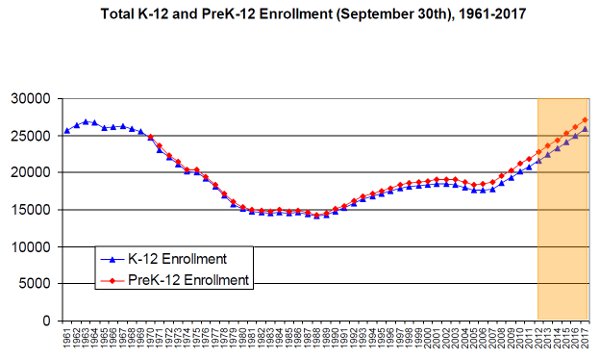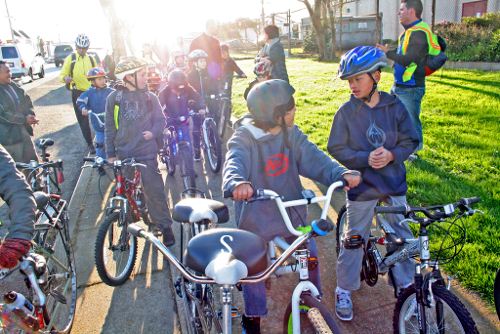Arlington County Virginia is an internationally recognized success story when it comes to urban design, smart growth, and land use but for decades families in Arlington County have felt ignored when it came to anticipating the need for hospitals, community centers, and most importantly schools. For the past decade they have played catch up as they saw astronomical growth of family oriented residents which have put serious strain on their annual budgets. This trend, much like the entire history of Arlington County’s rise, should serve advanced notice to Fairfax County for their future urban regions.

To understand the history of public facilities in Arlington you must understand the original mindsets that County planners had in mind in the 1980s and 1990s while the county experienced unprecedented development and growth. At that time it was assumed that future growth in the County would occur within the Rosslyn-Ballston corridor within high-density, multi-family buildings. It was also assumed that growth in these land uses would not drastically impact funding strategy and necessity for new schools, as almost all residents in this form of housing were anticipated to be without child.
This was a big mistake
 While the percentage of students coming from multi-family housing was relatively less than in established single family neighborhoods, the sheer number of new residents now living in Arlington caused a significant jump in enrollment. The mindset that only young unmarried professionals would live in Arlington was proven empirically false when many young professionals became small families who remained in urban cores. Not only was there a substantial increase in the number of enrollments, but there was also a new dessert of education being formed in the very urban core they lived. Established single family neighborhoods surrounding Washington Lee and Yorktown remained well connected, or easily modifiable, to the schools but younger families often found themselves several miles from their district’s school.
While the percentage of students coming from multi-family housing was relatively less than in established single family neighborhoods, the sheer number of new residents now living in Arlington caused a significant jump in enrollment. The mindset that only young unmarried professionals would live in Arlington was proven empirically false when many young professionals became small families who remained in urban cores. Not only was there a substantial increase in the number of enrollments, but there was also a new dessert of education being formed in the very urban core they lived. Established single family neighborhoods surrounding Washington Lee and Yorktown remained well connected, or easily modifiable, to the schools but younger families often found themselves several miles from their district’s school.
New bus routes were needed which pushed up operation costs through congested corridors. Expansions of more urban central schools were necessary which came at a premium on top of very expensive land within the commercial business district. Underlying all of the new spending necessary was the hidden cost to better connect this new population of students to the schools in the outlying neighborhoods via safe walking and biking paths.
 What occurred was an explosion in spending necessary to catch up to the new demographics. In fact spending per pupil grew 40% in 3 years alone during the mid-2000s. After a very expensive period of public funding, Arlington County was hopeful that K-6 students would not continue on to highschool within the County. Unfortunately, the very livable city they had created no longer was only attractive to 20-somethings. Many of those residents continued to live within Arlington and we are now seeing the County playing catch up to provide the upgrades necessary for this older (and more expensive) student body.
What occurred was an explosion in spending necessary to catch up to the new demographics. In fact spending per pupil grew 40% in 3 years alone during the mid-2000s. After a very expensive period of public funding, Arlington County was hopeful that K-6 students would not continue on to highschool within the County. Unfortunately, the very livable city they had created no longer was only attractive to 20-somethings. Many of those residents continued to live within Arlington and we are now seeing the County playing catch up to provide the upgrades necessary for this older (and more expensive) student body.
In many ways this trend should have been caught by planners in Arlington as they saw the per capita personal income grow rapidly beyond the typical caps of young professionals. Personal income rose far faster than the average income of a graduate or entry level job in the 2000s demonstrating that the average age of residents was rising not falling despite the continued growth restrained to multi-family developments.
This brings us to Fairfax County
Over the past 5 years Fairfax has expressed overtures of appreciation towards what Arlington County has been able to accomplish through smart growth. The entire plan for Tysons was crafted around the fundamentals incorporated in the Rosslyn-Ballston corridor. Areas of Falls Church, Merrifield, Reston, and McLean have all been reworked for revitalization concepts that can better connect the community via alternate transportation.
Fairfax has sadly ignored the mistakes that Arlington made, atleast to date. A lot of the growth pangs lived through experience could be avoided. The first step is recognizing that people of all kinds enjoy living in urban cores. Yes, it isn’t for some people who prefer space over comfort, but that distinction has a small correlation (at best) to age, and therefore household composite.

Step two? Start planning and designing for what will be the future population of school aged residents in urban regions of the County, before the area is established and expensive to correct. However funding assumptions continue to project Fairfax’s current levels of $13,500 per pupil, instead of the more realistic costs for urban capital projects and extensive population growth as experienced by Arlington (over $17,000 per pupil during major expansion periods).
To their credit, Fairfax has incorporated triggered construction of new schools within Tysons associated with population growth, but Tysons is just one of a number of growing urban regions within the County. Other parts of the county do not have the benefit of extremely large projects which can accommodate large levels of private funding for infrastructure (Schools often run in the 10s if not 100s of millions of dollars for construction).
 The key to these regions will be how to connect the existing communities to renovated and expanded schools in the current locations. Programs like Safe Routes provide much needed funding for trails, walkways, and cross walks that connect to schools, but without community buy in and use these programs go to waste. A trend that is upsetting many smart growth advocates is the increasing percentage of parents who drive their student to school. This trend wastes the availability of school bus services that are more efficient and reduce traffic, especially in urban corridors, but in many cases even these buses are not necessary if students walk or bike to school.
The key to these regions will be how to connect the existing communities to renovated and expanded schools in the current locations. Programs like Safe Routes provide much needed funding for trails, walkways, and cross walks that connect to schools, but without community buy in and use these programs go to waste. A trend that is upsetting many smart growth advocates is the increasing percentage of parents who drive their student to school. This trend wastes the availability of school bus services that are more efficient and reduce traffic, especially in urban corridors, but in many cases even these buses are not necessary if students walk or bike to school.
Breathe parents. We know that the world out there is a dangerous place, especially so along roads. A bit of education on proper routes not along dangerous commuter roads and often separated via trails and pedestrian bridges could put many parents at ease. Also a new trend, as seen on Nickelodeon (starring students from Vienna) and being promoted by local bicycling advocate JJ Madden, is the bike train. Beyond the power of numbers, JJ knows that safety education is crucial to real solutions. She has written extensively on the subject of safety and proper cycling on her website The Durable Human as well as participating her self in numerous bike trains for safe routes to school.
A combination of planning, budgeting, education, and advancing outdated perceptions will be necessary in Fairfax, and Arlington, if our region is serious about smart growth because multi-modal isn’t just for 20-something hipsters. If you don’t believe us, just look at the proof in Arlington.
Fairfax County Pupil Spending – WABE Guide Arlington County Budget/School Spending – ArlingtonVa.us
